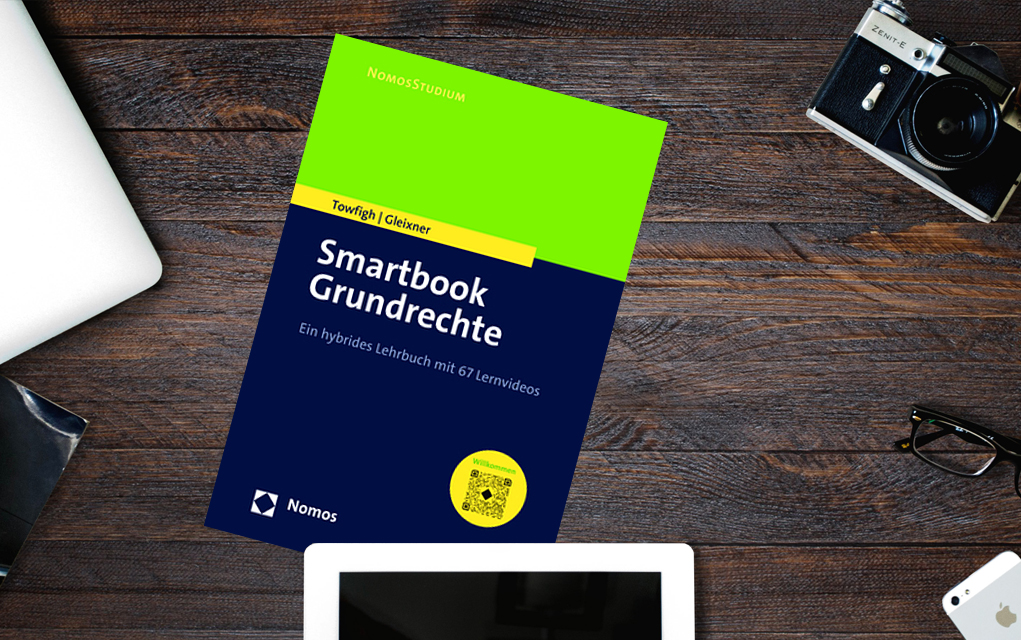Another basic rights textbook? No, at least not as it is known. Authors Towfigh and Gleixner are daring to do something new with their Smartbook core rights: their learning medium complements classic textbook content in digital learning formats such as educational videos and the Jurafuchs educational app. Additional literature, resolutions or contributions to the discussion can also be accessed via QR codes. Thus the concept of the law book takes a step towards digital learning. The smart book is both eBook as well as in one print version (Nomos) and will be published for the first time in November 2022. Another special feature: the e-book is open access – that is, free – available online. The smart book reminds you of the project OpenRewi.
Technical intricacies: symbols and links
But what makes the Basic Rights Smartbook “smarter” than traditional textbooks and how exactly does the digital add-on work? Quite simply: the learning medium contains a variety of links. Online learning offerings are particularly practical in the e-book version. Because here you can access rules, resolutions, issues, more literature and even podcast episodes with a single click. In addition, the Smartbook links to the appropriate educational videos and modules from Learn app Jura fox. The different digital displays are individually and clearly marked. In order to use these offers with the hard copy, your laptop, tablet or smartphone with a QR code scanner must be ready.
Classic building and more
In terms of structure, the Smartbook core rights don’t offer any great news. The classic structure is clear and provides a good orientation: starting with the general fundamental rights teaching, going through human dignity, freedom, and equal rights in law enforcement. It’s also clear: the authors have really thought about designing their smart book. Each chapter begins with learning and understanding the objectives, which also contribute to an overview of the content in question. Brief diagrams are presented at the end of the chapters. The medium is also comprehensive and easy to understand in terms of content, in part due to its many examples and decision-making discussions. Both the newer problems and the fundamental rights classics find their place here.
.
The learning method is suitable for both first-year students and exam candidates. This is achieved by marking in-depth topics as such. Another positive aspect is that the content is organized through questions. This can also be used, for example, for self-monitoring. They can also provide educational support for the oral exam.
the best in the world?
Whether you are an audio learner, user of the app or a fan of textbooks: Overall, Towfigh / Gleixner offers something for everyone with their innovative concept. It is also clear that more time can be spent with the Fundamental Rights Smart Book and its additional offerings than with the classic Basic Rights Book. Here perhaps lies the crux of the matter. Despite the many options, the smart book is not burdened with QR codes. However, the user must first find out which of the offers are really useful for him. Because working through all of the content seems fancy – and may not be the point of the learning medium. In this way, the medium makes it easier to research and access additional learning content.
The educational videos are kept very simple and organized in the same way as the linked book chapters. Here the authors could have gone ahead and used illustrative illustrations, for example. However, they are easy to understand and rhetorically attractive. Even with a length of approximately five to fifteen minutes, the majority of videos can be consumed as “bits”. They seem best suited for a recurring summary.
Conclusion: a well-thought-out concept for all cases
The Smart Book of Fundamental Rights by Towfigh and Gleixner is a textbook for the 21st century. Additional digital displays allow you to quickly and easily search for laws and more literature. In addition, the smart book combines different methods of acquiring knowledge. Whether it’s case tests, educational videos or knowledge questions about Jurafuchs: everyone will find their favorite way of learning here. Nevertheless, the work remains classic in its structure and content. It gives a very good overview. It is also worth emphasizing: due to the open access, all law students can take advantage of this offer. And he deserves it. For first reading, to search for, to listen again or to deepen existing knowledge.

Mr. Dr. Emmanuel F He is Head of Public Law, Empirical Legal Research and Legal Economics at the EBS Law School in Wiesbaden.
Alexander Glickner Associate researcher in the Professor Tawfiq chair and is attending a doctorate in anti-discrimination law.

“Explorer. Communicator. Music geek. Web buff. Social media nerd. Food fanatic.”







More Stories
A fossilized creature may explain a puzzling drawing on a rock wall.
MrBeast Sued Over ‘Unsafe Environment’ on Upcoming Amazon Reality Show | US TV
Watch comets Lemmon and SWAN approach Earth today